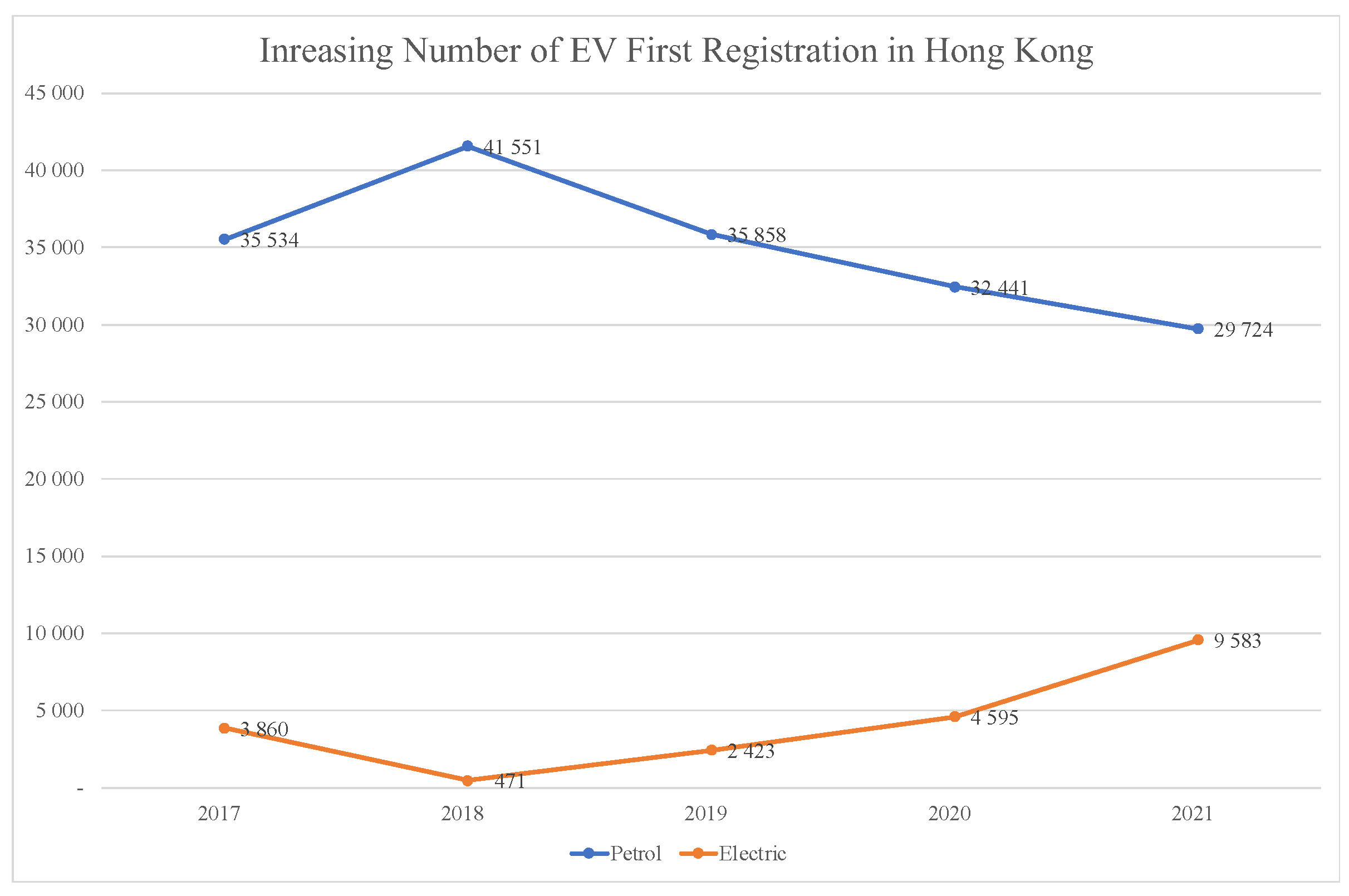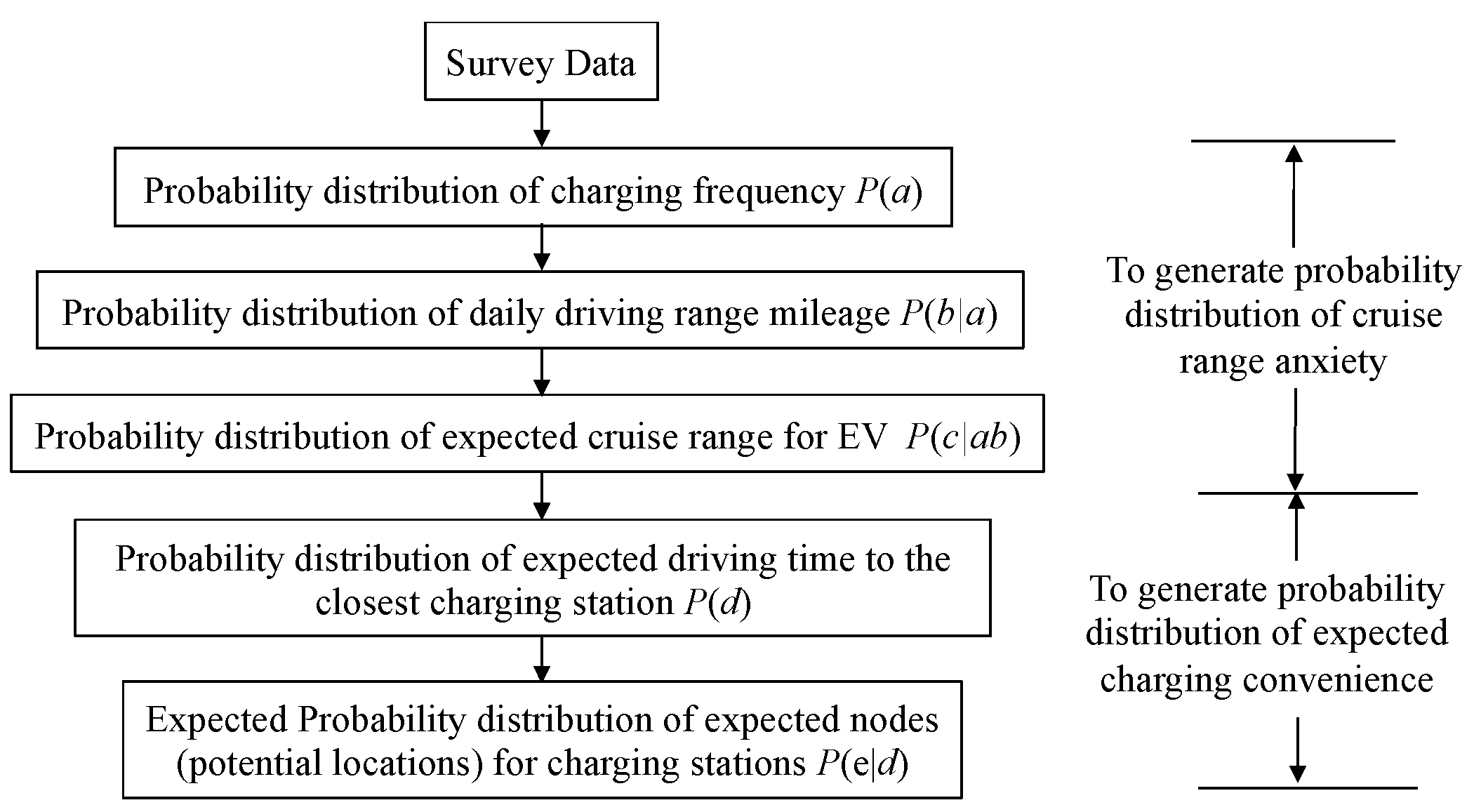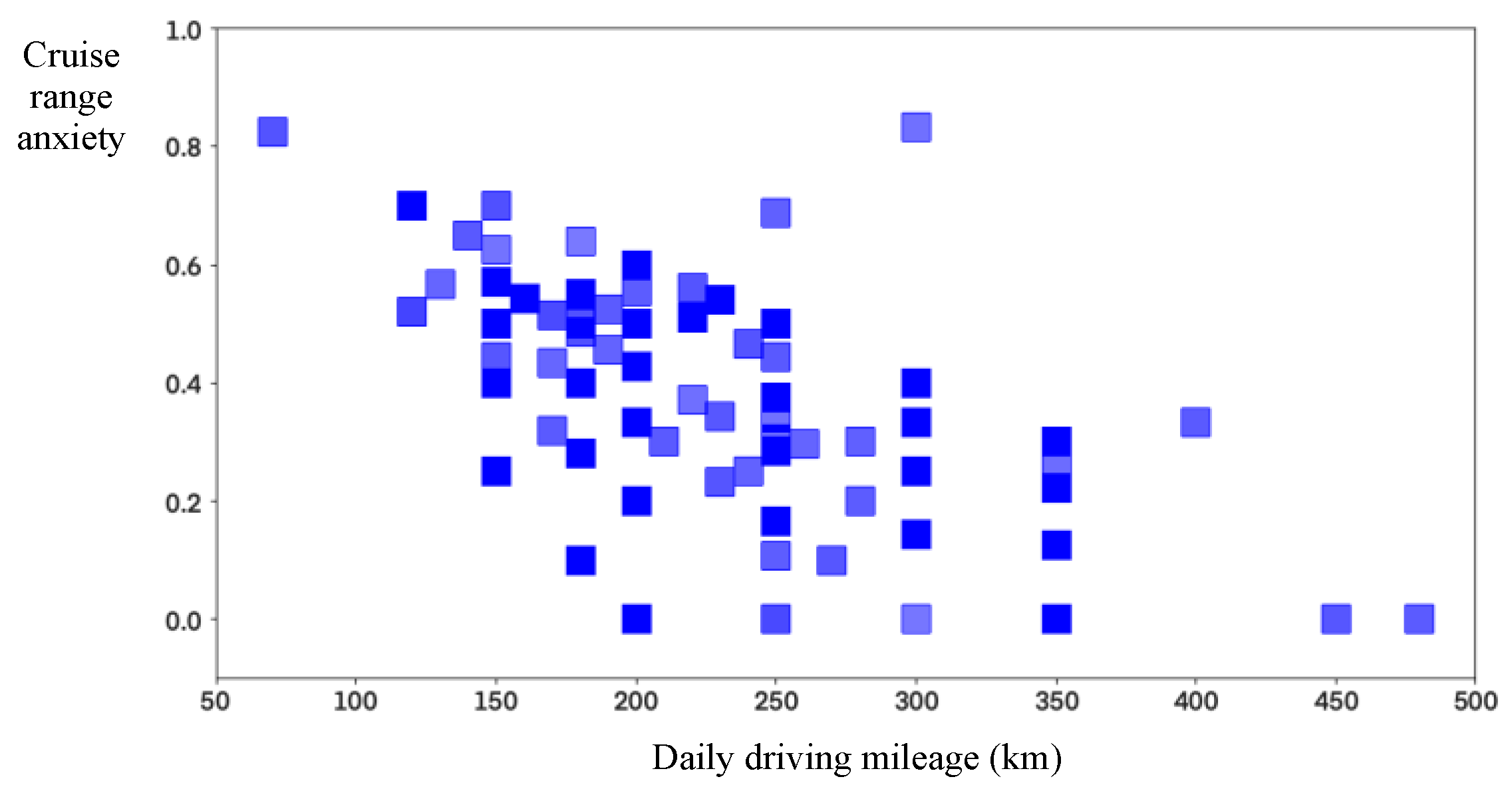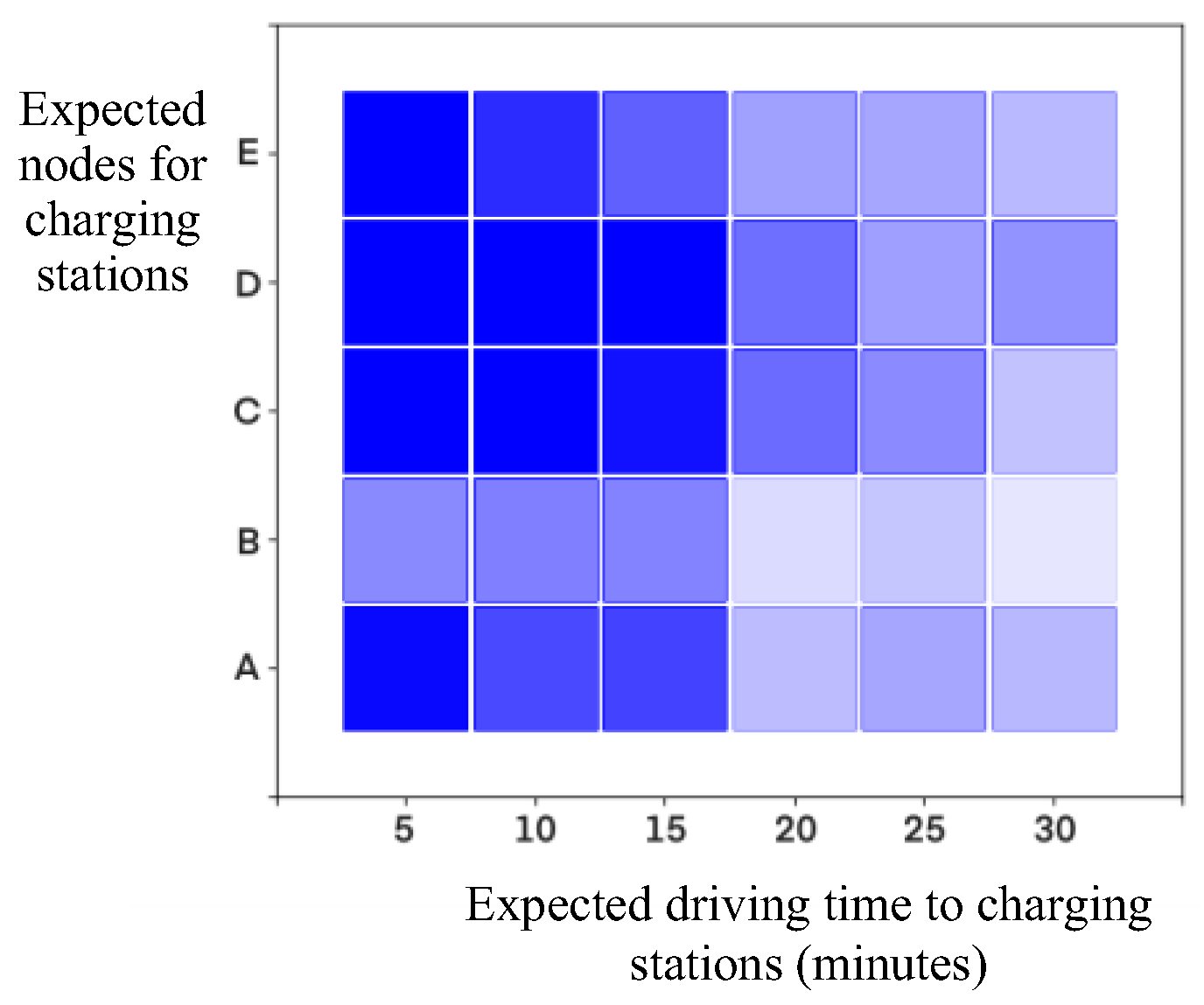A Preliminary Feasibility Study of Electric Taxi Promotion in Hong Kong—Behavior Modelling of Driving Patterns and Preferences
Abstract
1. Introduction
2. Overview of Electric Vehicles and Electric Taxis in Hong Kong
2.1. The Evolution of Taxi
2.2. On the Move: Encouraging Diesel Taxi to LPG Taxi
2.3. Initiation of Electric Taxis in Hong Kong
3. Research Methodology
4. Numerical Analysis and Simulation Results
4.1. Sampling
4.2. Modelling and Simulation
5. Discussion
6. Conclusions
Author Contributions
Funding
Institutional Review Board Statement
Informed Consent Statement
Data Availability Statement
Acknowledgments
Conflicts of Interest
References
- Scorrano, M.; Danielis, R.; Giansoldati, M. Mandating the use of the electric taxis: The case of Florence. Transp. Res. Part A Policy Pr. 2020, 132, 402–414. [Google Scholar] [CrossRef]
- Keawthong, P.; Muangsin, V.; Gowanit, C. Location Selection of Charging Stations for Electric Taxis: A Bangkok Case. Sustainability 2022, 14, 11033. [Google Scholar] [CrossRef]
- Yang, W.; Wong, R.; Szeto, W. Modeling the acceptance of taxi owners and drivers to operate premium electric taxis: Policy insights into improving taxi service quality and reducing air pollution. Transp. Res. Part A Policy Pr. 2018, 118, 581–593. [Google Scholar] [CrossRef]
- Transport Department HKSAR. 2022. Available online: https://www.td.gov.hk/en/transport_in_hong_kong/public_transport/taxi/index.html (accessed on 7 September 2022).
- Razzaq, A.; Cui, Y.; Irfan, M.; Maneengam, A. Asymmetric effects of fine particulate matter and stringency policy on COVID-19 intensity. Int. J. Environ. Health Res. 2022, 32, 1–10. [Google Scholar] [CrossRef] [PubMed]
- Kaya, O.; Alemdar, K.D.; Çodur, M.Y. A novel two stage approach for electric taxis charging station site selection. Sustain. Cities Soc. 2020, 62, 102396. [Google Scholar] [CrossRef]
- Lin, C.; Lin, C. The p-center flow-refueling facility location problem. Transp. Res. Part B 2018, 118, 124–142. [Google Scholar] [CrossRef]
- Wu, Y.; Lau, Y.-Y.; Wu, J.-A. Integration of Electric Vehicles into Microgrids: Policy Implication for the Industrial Application of Carbon Neutralisation in China. World Electr. Veh. J. 2022, 13, 96. [Google Scholar] [CrossRef]
- Chong, G. Hidden Hong Kong: A history of the Iconic Hong Kong Taxi. 2021. Available online: https://www.localiiz.com/post/culture-history-taxi-local-public-transportation-hong-kong (accessed on 25 September 2021).
- Yang, H.; Wong, S.C. A network model of urban taxi services. Transp. Res. Part B Methodol. 1998, 32, 235–246. [Google Scholar] [CrossRef]
- Xu, J.; Yan, L.; Mak, C.K. Service encounter failure, negative destination emotion and behavioral intention: An experimental study of taxi service. Tour. Manag. Perspect. 2021, 40, 100886. [Google Scholar] [CrossRef]
- Newcombe, K.; Kalma, J.; Aston, A.R. The metabolism of a city: The case of Hong Kong. Ambio 1978, 7, 3–15. [Google Scholar]
- Transport Department HKSAR. 2007. Available online: https://www.info.gov.hk/gia/general/200703/28/P200703260091.htm (accessed on 8 August 2021).
- Adhikari, A.; Mukherjee, S. The New Amby: The Second Debut. Asian Case Res. J. 2019, 23, 39–63. [Google Scholar] [CrossRef]
- Patunru, A.A.; Minato, K.; Hori, M.; Hirota, K. ERIA Research Project 2008 No. 7, Sustainable Automobile Society in East Asia; Economic Research Institute for ASEAN and East Asia: Jakarta, Indonesia, 2009. [Google Scholar]
- Frost, S.L.; Frost, A.K. Taxi Shanghai: Entrepreneurship and semi-colonial context. Bus. Hist. 2021, 1–30. [Google Scholar] [CrossRef]
- Legislative Council of the HKSAR. Promoting the Use of Electric Vehicles. 2020. Available online: https://www.legco.gov.hk/yr19-20/english/panels/ea/ea_ev/papers/ea_ev20200511cb1-589-1-e.pdf (accessed on 7 September 2022).
- DieselNet. 2022. Available online: https://dieselnet.com/standards/eu/ld.php (accessed on 1 August 2022).
- Sustainable Business Toolkit. 2022. Benefits of LPG vs Petrol Vehicles. Available online: https://www.sustainablebusinesstoolkit.com/lpg-vs-petrol-vehicles/ (accessed on 10 July 2022).
- Legislative Council of the HKSAR. A Study on LPG as a Fuel for Vehicles. 1997. Available online: https://www.legco.gov.hk/yr97-98/english/sec/library/967rp05.pdf (accessed on 6 June 2022).
- Zheng, X.; Lin, H.; Liu, Z.; Li, D.; Llopis-Albert, C.; Zeng, S. Manufacturing Decisions and Government Subsidies for Electric Vehicles in China: A Maximal Social Welfare Perspective. Sustainability 2018, 10, 672. [Google Scholar] [CrossRef]
- Lau, Y.Y.; Wu, A.Y.; Mak, W.Y. A way forward for electric vehicle in Greater Bay Area: Challenges and opportunities for the 21st century. Vehicles 2022, 4, 420–432. [Google Scholar] [CrossRef]
- Wu, Y.A.; Ng, A.W.; Yu, Z.; Huang, J.; Meng, K.; Dong, Z. A review of evolutionary policy incentives for sustainable development of electric vehicles in China: Strategic implications. Energy Policy 2021, 148, 111983. [Google Scholar] [CrossRef]
- Singtao. Electric New Taxi BYD e6 Taxi Ready for Trial Early Next Year. 2021. Available online: https://std.stheadline.com/supplement/article/2422583 (accessed on 8 August 2021).
- Ng, E. All New Cars in Hong Kong Could Be Electric by 2030, Five Years Ahead of Schedule. 2022. Available online: https://www.scmp.com/business/article/3157974/all-new-cars-hong-kong-could-be-electric-2030-five-years-ahead-schedule#:~:text=park%20by%20itself-,Chinese%20XPeng%20electric%20car%20can%20drive%20and%20park%20by%20itself,lower%20than%20for%20petrol%20cars (accessed on 8 September 2022).
- Lau, Y.Y.; Wu, A.Y.; Mak, W.Y. Electric vehicle charging infrastructures in the Greater Bay Area of China: Progress, challenges and efforts. Front. Future Transp. 2022, 3, 893583. [Google Scholar] [CrossRef]
- Lau, Y.-Y.; Yip, T.-L.; Dulebenets, M.A.; Tang, Y.-M.; Kawasaki, T. A Review of Historical Changes of Tropical and Extra-Tropical Cyclones: A Comparative Analysis of the United States, Europe, and Asia. Int. J. Environ. Res. Public Health 2022, 19, 4499. [Google Scholar] [CrossRef] [PubMed]




| Group | Variables | Notation | Related Questions in the Survey |
|---|---|---|---|
| The anxiety of cruise range | Charging frequency | a | How many times would you accept to charge your car for a full-day operation? |
| Daily driving mileage | b | How many kilometers does the taxi driver usually travel per day? | |
| Preferred cruise range | c | What is the preferred cruise range for electric taxi drivers? | |
| The convenience of charging facilities | Cruise time to arrive at closest charging stations | d | What is the acceptable driving time to the closest charging stations? |
| Locations of charging stations | e | Where should new charging facilities be installed? | |
| Incentives | Subsidy | f | What is the acceptable financial subsidy for electric taxi purchases and for transport operation? |
Disclaimer/Publisher’s Note: The statements, opinions and data contained in all publications are solely those of the individual author(s) and contributor(s) and not of MDPI and/or the editor(s). MDPI and/or the editor(s) disclaim responsibility for any injury to people or property resulting from any ideas, methods, instructions or products referred to in the content. |
© 2023 by the authors. Licensee MDPI, Basel, Switzerland. This article is an open access article distributed under the terms and conditions of the Creative Commons Attribution (CC BY) license (https://creativecommons.org/licenses/by/4.0/).
Share and Cite
Wu, Y.A.; Lau, Y.-Y.; Wong, L.M.; Wu, J. A Preliminary Feasibility Study of Electric Taxi Promotion in Hong Kong—Behavior Modelling of Driving Patterns and Preferences. Appl. Sci. 2023, 13, 1491. https://doi.org/10.3390/app13031491
Wu YA, Lau Y-Y, Wong LM, Wu J. A Preliminary Feasibility Study of Electric Taxi Promotion in Hong Kong—Behavior Modelling of Driving Patterns and Preferences. Applied Sciences. 2023; 13(3):1491. https://doi.org/10.3390/app13031491
Chicago/Turabian StyleWu, Yang Andrew, Yui-Yip Lau, Lok Man Wong, and Juai Wu. 2023. "A Preliminary Feasibility Study of Electric Taxi Promotion in Hong Kong—Behavior Modelling of Driving Patterns and Preferences" Applied Sciences 13, no. 3: 1491. https://doi.org/10.3390/app13031491
APA StyleWu, Y. A., Lau, Y.-Y., Wong, L. M., & Wu, J. (2023). A Preliminary Feasibility Study of Electric Taxi Promotion in Hong Kong—Behavior Modelling of Driving Patterns and Preferences. Applied Sciences, 13(3), 1491. https://doi.org/10.3390/app13031491







